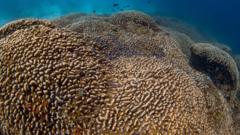Scientists have announced the discovery of the largest known coral in the world, found in the southwestern Pacific Ocean. This giant coral, which is actually a colony of connected polyps forming a single organism, measures an impressive 34 meters in width and is estimated to be over 300 years old. Videographer Manu San Felix made the discovery during a dive while working on a National Geographic expedition aimed at understanding climate change impacts in the remote Pacific.
**World’s Largest Coral Discovery in the Pacific Ocean**

**World’s Largest Coral Discovery in the Pacific Ocean**
A massive coral colony larger than a blue whale has been discovered in the Solomon Islands, signaling hope amidst climate change threats.
Upon discovering the coral, whose size evoked emotions akin to witnessing an underwater cathedral, San Felix noted its historical significance, stating it was present during the age of Napoleon. The expedition team verified its dimensions in deeper waters, suggesting that this location might have shielded it from rising sea surface temperatures that are harming other coral reefs globally.
Coral reefs are crucial for marine biodiversity and the livelihoods of over one billion people globally, enriching economies through tourism and fishing. The announcement of this coral’s discovery coincided with the COP29 climate talks in Baku, where Solomon Islands’ Climate Minister Trevor Manemahaga emphasized the need for global recognition and protection of this vital marine environment.
He highlighted the adverse effects of climate change on small island nations like the Solomon Islands, which face increased cyclones and coastal erosion. The minister also pointed to the importance of securing financial support from wealthier nations to diversify job opportunities and reduce reliance on industries, like logging, that harm coral ecosystems.
Despite the surrounding challenges, marine biologist Eric Brown expressed optimism upon discovering this healthy coral. Its type, Pavona clavus, supports a diverse range of marine life and provides valuable insights into historical ocean conditions. However, alarming reports indicate that nearly half of the corals in warm waters face extinction threats, amplifying the urgency for climate action to preserve these vital ecosystems.
With the coral serving as a hopeful beacon amidst environmental struggles, scientists are eager to study this majestic specimen further, while advocating for enhanced protective measures for fragile marine habitats.
Coral reefs are crucial for marine biodiversity and the livelihoods of over one billion people globally, enriching economies through tourism and fishing. The announcement of this coral’s discovery coincided with the COP29 climate talks in Baku, where Solomon Islands’ Climate Minister Trevor Manemahaga emphasized the need for global recognition and protection of this vital marine environment.
He highlighted the adverse effects of climate change on small island nations like the Solomon Islands, which face increased cyclones and coastal erosion. The minister also pointed to the importance of securing financial support from wealthier nations to diversify job opportunities and reduce reliance on industries, like logging, that harm coral ecosystems.
Despite the surrounding challenges, marine biologist Eric Brown expressed optimism upon discovering this healthy coral. Its type, Pavona clavus, supports a diverse range of marine life and provides valuable insights into historical ocean conditions. However, alarming reports indicate that nearly half of the corals in warm waters face extinction threats, amplifying the urgency for climate action to preserve these vital ecosystems.
With the coral serving as a hopeful beacon amidst environmental struggles, scientists are eager to study this majestic specimen further, while advocating for enhanced protective measures for fragile marine habitats.





















